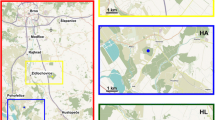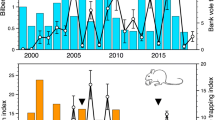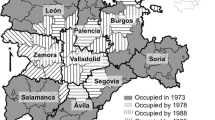Abstract
Acorn crops and rodent populations [bank vole (Myodes glareolus), yellow-necked mouse (Apodemus flavicollis), and wood mouse (Apodemus sylvaticus)] were monitored for 11 years (2002–2012) in mature oak commercial forests in South Moravia (the Czech Republic). Large acorn crops, marking so-called seed years, were recorded in 2003, 2006, 2009, 2010, and 2011. Acorn crops were repeated with period of 3–4 years. The abundance of all three species correlated positively with size of the acorn crop in the previous year. However, significant relationship between the size of the crop and grow of the population was found only in Apodemus flavicollis. Probably because of its food specialty, this species was most affected by acorn crops. Acorn crops had an effect on the breeding season of all monitored rodent species. In autumn of the seed years, the breeding period was prolonged in both Apodemus species; on the contrary, the crop had no major impact on bank voles. The higher the crop, the earlier A. flavicollis began to reproduce in the spring and the sooner it reached its peak and end of reproduction in a given year. The beginning, peak, and end of reproduction were significantly later in bank vole than in Apodemus spp. Lower North Atlantic Oscillation index (i.e. higher temperatures in the vegetation season and lower during winter, “NAO” hereinafter) was more suitable for Apodemus flavicollis. Higher values of the wNAO (winter NAO index) had a positive impact on Apodemus spp. while bank voles were not affected by this.








Similar content being viewed by others
References
Andrzejewski R, Olszewski J (1963) Social behaviour and interspecific relations in Apodemus flavicollis (Melchior, 1834) and Clethrionomys glareolus (Schreber, 1780). Acta Theriol (Warsz) 7:165–168
Ascoli D, Vacchiano G, Turco M et al (2017) Inter-annual and decadal changes in teleconnections drive continental-scale synchronization of tree reproduction. Nat Commun 8:1–9. https://doi.org/10.1038/s41467-017-02348-9
Batzli GO (1983) Herbivore-plant interactions at northern latitudes. Oikos 40:396–406
Begon M, Townsend CR, Harper JL (2005) Ecology: From individuals to ecosystems, 2nd edn. Wiley-Blackwell, Oxford
Beranová R, Kyselý J (2017) Trends of precipitation characteristics in the Czech Republic over 1961–2012, their spatial patterns and links to temperature and the North Atlantic Oscillation. Int J Climatol 38:e596–e606. https://doi.org/10.1002/joc.5392
Bergstedt B (1965) Distribution, reproduction, growth and dynamics of the rodent species Clethrionomys glareolus (Schreber), Apodemus flavicollis (Melchior) and Apodemus sylvaticus (Linné) in Southern Sweden. Oikos 16:132–160. https://doi.org/10.2307/3564871
Bobek B (1973) Net production of small rodents in deciduous forest. Acta Theriol (Warsz) 18:403–434. https://doi.org/10.4098/at.arch.73-25
Bogdziewicz M, Szymkowiak J (2016) Oak acorn crop and Google search volume predict Lyme disease risk in temperate Europe. Basic Appl Ecol 17:300–307. https://doi.org/10.1016/j.baae.2016.01.002
Bogdziewicz M, Zwolak RR, Crone EE (2015) How do vertebrates respond to mast seeding? Oikos 125:300–307. https://doi.org/10.1111/oik.03012
Bogdziewicz M, Fernández-Martínez M, Bonal R et al (2017) The Moran effect and environmental vetoes: phenological synchrony and drought drive seed production in a Mediterranean oak. Proc R Soc B Biol Sci 284:20171784. https://doi.org/10.1098/rspb.2017.1784
Bogdziewicz M, Szymkowiak J, Fernández-Martínez M et al (2019) The effects of local climate on the correlation between weather and seed production differ in two species with contrasting masting habit. Agric For Meteorol 268:109–115. https://doi.org/10.1016/j.agrformet.2019.01.016
Butet A, Delettre YR (2011) Diet differentiation between European arvicoline and murine rodents. Acta Theriol (Warsz) 56:297–304. https://doi.org/10.1007/s13364-011-0049-6
Caignard T, Kremer A, Firmat C et al (2017) Increasing spring temperatures favor oak seed production in temperate areas. Sci Rep 7:8555. https://doi.org/10.1038/s41598-017-09172-7
Caignard T, Delzon S, Bodénès C et al (2019) Heritability and genetic architecture of reproduction-related traits in a temperate oak species. Tree Genet Genomes 15:12. https://doi.org/10.1007/s11295-018-1309-2
Čepelka L, Heroldová M, Jánová E, Suchomel J (2014) The Dynamics of nitrogenous substances in rodent diet in a forest environment. Mammalia 78:327–333. https://doi.org/10.1515/mammalia-2013-0017
Cox PG, Rayfield EJ, Fagan MJ et al (2012) Functional evolution of the feeding system in rodents. PLoS ONE. https://doi.org/10.1371/journal.pone.0036299
Donat MG, Leckebusch GC, Pinto JG, Ulbrich U (2010) Examination of wind storms over Central Europe with respect to circulation weather types and NAO phases. Int J Climatol 30:1289–1300. https://doi.org/10.1002/joc.1982
Drobyshev I, Niklasson M, Mazerolle MJ, Bergeron Y (2014) Reconstruction of a 253-year long mast record of European beech reveals its association with large scale temperature variability and no long-term trend in mast frequencies. Agric For Meteorol 192–193:9–17. https://doi.org/10.1016/j.agrformet.2014.02.010
Fasola M, Canova L (2000) Asymmetrical competition between bank vole and wood mouse, a removal experiment. Acta Theriol (Warsz) 45:353–365
Fernández-Martínez M, Belmonte J, Maria Espelta J (2012) Masting in oaks: disentangling the effect of flowering phenology, airborne pollen load and drought. Acta Oecol 43:51–59. https://doi.org/10.1016/j.actao.2012.05.006
Flowerdew JR, Gurnell J, Gipps JHW (1985) The Ecology of woodland rodents: bank voles and wood mice: the Proceedings of a symposium held at the Zoological Society of London on 23rd and 24th of November 1984. In: The Ecology of woodland rodents: bank voles and wood mice: the Proceedings of a symposium held at the Zoological Society of London on 23rd and 24th of November 1984. Oxford University Press, London, p 418
Garrison BA, Koenig WD, Knops JMH (2008) Spatial synchrony and temporal patterns in acorn production of California black oaks. General Technical Repot - Pacific Southwest Res Station USDA For Serv 343–356
Geuse P, Bauchau V (1985) Apodemus sylvaticus (Rodentia: muridae) et Clethrionomys glareolus (Rodentia: Microtidae) competition or coexistence? Ann la Société R Zool Belgique 115:211–220
Gliwicz J (1988) Seasonal dispersal in non-cyclic populations of Clethrionomys glareolus and Apodemus flavicollis. Acta Theriol (Warsz) 33:263–272. https://doi.org/10.4098/at.arch.88-20
Grüm L, Bujalska G (2000) Bank voles and yellow-necked mice: what are interrelations between them? Polish J Ecol 48:141–145
Gurnell J (1981) Woodland rodents and tree seed supplies. The Worldwide furbearer conference proceedings. R. R. Donnely a Sons Co., Falls Chard (Virginia), pp 1194–1214
Gurnell J (1985) Woodland rodent communities. In: Flowerdew JR, Gurnell J, Gipps JHW (eds) The Ecology of Woodland Rodents Bank Voles and Wood Mice. Zoological Society of London Symposia 55, Oxford, pp 377–411
Hansson L (1971) Estimates of the productivity of small mammals in a South Swedish spruce plantation. Ann Zool Fennici 8:118–126
Holišová V (1960) Potrava myšice lesní Apodemus sylvaticus L. na Českomoravské vysočině. Zool List 9:135–158
Holišová V (1966) Food of an overcrowded population of the bank vole, Clehtrionomys glareolus Schreb. in a lowland forest. Zool List 15:207–224
Holišová V (1969) Vertical movements of some small mammals in forest. Folia Zool 18:121–141
Hubálek Z (2005) North Atlantic weather oscillation and human infectious diseases in the Czech Republic, 1951–2003. Eur J Epidemiol 20:263–270. https://doi.org/10.1007/s10654-004-6518-3
Hurrell JW (1995) Decadal trends in the North Atlantic Oscillation: regional temperatures and precipitation. Science 269:676–679
Jánová E, Heroldová M, Čepelka L (2016) Rodent food quality and its relation to crops and other environmental and population parameters in an agricultural landscape. Sci Total Environ 562:164–169. https://doi.org/10.1016/j.scitotenv.2016.03.165
Jędrzejewska B, Pucek Z, Jędrzejewski W (2004) Seed crops and forest rodents. In: Essays on Mammals of Bialowieza Forest. Polish Academy of Sciences, Bialowieza, p 214
Jensen TS (1982) Seed production and outbreaks of non-cyclic rodent populations in deciduous forests. Oecologia (Berlin) 54:184–192
Jensen TS (1985) Seed-seed interactions of European beech, Fagus silvatica and forest rodents, Clethrionomys glareolus and Apodemus flavicollis. Oikos 44:149–156. https://doi.org/10.2307/3544056
Jovanović M, Tudović A (1975) Genetics of common and sessilie oak (Quercus robur L. and Q. petraea Liebl.). Ann For 7:23–53
Juškaitis R (2002) Spatial distribution of the yellow-necked mouse (Apodemus flavicollis) in large forest areas and its relation with seed crop of forest trees. Mamm Biol 67:206–211. https://doi.org/10.1078/1616-5047-00031
Kasprzyk I, Ortyl B, Dulska-Jez A (2014) Relationships among weather parameters, airborne pollen and seed crops of Fagus and Quercus in Poland. Agric For Meteorol 197:111–122. https://doi.org/10.1016/j.agrformet.2014.05.015
Kelly D, Turnbull MH, Pharis RP, Sarfati MS (2008) Mast seeding, predator satiation, and temperature cues in Chionochloa (Poaceae). Popul Ecol 50:343–355. https://doi.org/10.1007/s10144-008-0109-1
Klimo E, Hager H, Matič S, et al (2008) Floodplain forests of the temperate zone of Europe. Lesnická práce
Knape J, de Valpine P (2011) Effects of weather and climate on the dynamics of animal population time series. Proc R Soc B Biol Sci 278:985–992. https://doi.org/10.1098/rspb.2010.1333
Koenig WD, Knops JMH (2000) Patterns of annual seed production by Northern Hemisphere trees: a global perspective. Am Nat 155:59–69. https://doi.org/10.1086/303302
Labudová L, Šťastný P, Trizna M (2013) The north atlantic oscillation and winter precipitation totals in Slovakia. Morav Geogr Rep 21:38–49. https://doi.org/10.2478/mgr-2013-0019
Lalonde RG, Roitberg BD (1992) Field Studies of Seed Predation in an Introduced Weedy Thistle. Oikos 65:363–370. https://doi.org/10.2307/3545551
Lebourgeois F, Delpierre N, Dufrêne E et al (2018) Assessing the roles of temperature, carbon inputs and airborne pollen as drivers of fructification in European temperate deciduous forests. Eur J For Res 137:349–365. https://doi.org/10.1007/s10342-018-1108-1
Martiník A, Dobrovolný L, Palátová E (2014) Tree growing space and acorn production of Quercus robur. Dendrobiology 71:101–108. https://doi.org/10.12657/denbio.071.010
Montgomery WI (1981) A removal experiment with sympatric populations of Apodemus sylvaticus (L.) and A. flavicollis (Melchior) (Rodentia: Muridae). Oecologia 51:123–132. https://doi.org/10.1007/BF00344662
Nussbaumer A, Waldner P, Etzold S et al (2016) Patterns of mast fruiting of common beech, sessile and common oak, Norway spruce and Scots pine in Central and Northern Europe. For Ecol Manage 363:237–251. https://doi.org/10.1016/j.foreco.2015.12.033
Obrtel R, Holisova V (1974) Povaha potravy Apodemus flavicollis a Clethrionomys glareolus v lužním lese. Lynx 16:37–45
Ostfeld RS, Jones CG, Wolff JO (1996) Of mice and mast. Bioscience 46:323–330. https://doi.org/10.2307/1312946
Pedersen AB, Greives TJ (2008) The interaction of parasites and resources cause crashes in a wild mouse population. J Anim Ecol 77:370–377. https://doi.org/10.1111/j.1365-2656.2007.01321.x
Pelikán J (1966) Analyse von drei populations dynamischen Faktoren bei Apodemus flavicollis (Melch.). Z F Saugetierkd 31:31–37
Pérez-Ramos IM, Ourcival JM, Limousin JM, Rambal S (2010) Mast seeding under increasing drought: results from a long-term data seat and from a rainfall exclusion experiment. Ecology 91:3057–3068. https://doi.org/10.1890/09-2313.1
Petrusewicz K (1983) Ecology of the bank vole Introduction. Acta Theriol (Warsz) 28:1–2
Pucek Z, Jedrzejewski W, Jedrzejewska B, Pucek M (1993) Rodent population dynamics in a primeval deciduous forest (Bialowieza National Park) in relation to weather, seed crop, and predation. Acta Theriol (Warsz) 38:199–232. https://doi.org/10.4098/AT.arch.93-18
Pulliam HR, Danielson BJ (1991) Sources, sinks, and habitat selection: a landscape perspective on population dynamics. Am Nat 137:S50–S66. https://doi.org/10.1086/285139
Schmidt KA, Ostfeld RS (2008) Numerical and behavioral effects within a pulse-driven system: consequences for shared prey. Ecology 89:635–646
Selås V, Framstad E, Spidsoe TK et al (2002) Effects of seed masting of bilberry, oak and spruce on sympatric populations of bank vole (Clethrionomys glareolus) and wood mouse (Apodemus sylvaticus) in southern Norway. J Zool 258:459–468. https://doi.org/10.1017/S0952836902001619
Shaw MW (1974) The reproductive characteristics of oak. In: Morris MG, Perring FH (eds) The British Oak. Classey, Faringdon, pp 162–181
Šipoš J, Suchomel J, Purchart L, Kindlmann P (2017) Main determinants of rodent population fluctuations in managed Central European temperate lowland forests. Mammal Res 62:283–295. https://doi.org/10.1007/s13364-017-0316-2
Smyth M (1966) Winter breeding in woodland mice, Apodemus Sylvaticus, and Voles, Clethrionomys Glareolus and Microtus Agrestis, near Oxford. J Anim Ecol 35:471–485. https://doi.org/10.2307/2486
Solonen T, Ahola P (2010) Intrinsic and extrinsic factors in the dynamics of local small-mammal populations. Can J Zool 88:178–185. https://doi.org/10.1139/Z09-138
Stenseth NC, Mysterud A, Ottersen G et al (2002a) Ecological effects of climate fluctuations. Science 297:1292–1296
Stenseth NC, VIljugrein H, Jędrzejewski W et al (2002b) Population dynamics of Clethrionomys glareolus and Apodemus flavicollis: seasonal components of density dependence and density independence. Acta Theriol (Warsz) 47:39–67. https://doi.org/10.1007/BF03192479
Stenseth NC, Ottersen G, Hurrell JW et al (2003) Studying climate effects on ecology through the use of climate indices: the North Atlantic Oscillation, El Niñ o Southern oscillation and beyond. Proc R Soc London 270:2087–2096. https://doi.org/10.1098/rspb.2003.2415
Suchomel J, Heroldová M (2008) Effect of seed crop of trees on the abundance and body parameters of granivorous mammals in isolated forest stands of southern Moravia (Czech Republic). Pol. Polish J Ecol 56:181–186
Suchomel J, Purchart L, Čepelka L, Heroldová M (2016) Factors influencing vole bark damage intensity in managed mountain-forest plantations of Central Europe. Eur J For Res 135:331–342. https://doi.org/10.1007/s10342-016-0938-y
Sunyer P, Muñoz A, Bonal R, Espelta JM (2013) The ecology of seed dispersal by small rodents: a role for predator and conspecific scents. Funct Ecol 27:1313–1321. https://doi.org/10.1111/1365-2435.12143
Sunyer P, Espelta JM, Bonal R, Muñoz A (2014) Seeding phenology influences wood mouse seed choices: the overlooked role of timing in the foraging decisions by seed-dispersing rodents. Behav Ecol Sociobiol 68:1205–1213. https://doi.org/10.1007/s00265-014-1731-x
Svoboda P (1955) Forest tree species and stands II. SZN, Prague
Tkadlec E, Václavík T, Široký P (2019) Rodent host abundance and climate variability as predictors of tickborne disease risk 1 year in advance. Emerg Infect Dis 25:1738–1741. https://doi.org/10.3201/eid2509.190684
Unnsteinsdóttir ER (2014) The wood mouse Apodemus sylvaticus in Iceland: population dynamics and limiting factors at the northern edge of the species’ range
Vaňková K (2004) Natural regeneration of oak in floodplain forest (“Přirozená obnova dubu v lužním lese”. MZLU Brno, In Czech)
Watts CHS (1969) The regulation of wood mouse (Apodemus sylvaticus) numbers in wytham woods, Berkshire. J Anim Ecol 38:285–304. https://doi.org/10.2307/2772
White TCR (2008) The role of food, weather and climate in limiting the abundance of animals. Biol Rev 83:227–248. https://doi.org/10.1111/j.1469-185X.2008.00041.x
Zejda J (1961) Age-structure on populations of the bank vole, Clethrionomys glareolus Schreber 1780. Zool List 10:249–264
Zejda J (1962) Winter breeding in the bank vole, Clethrionomys glareolus Schreb. Zool List 11:309–322
Zejda J (2002) Yellow-necked mouse attacked a dead bank vole. Acta Theriol (Warsz) 47:221–222. https://doi.org/10.1007/BF03192462
Zejda J, Zapletal M, Pikula J et al (2002) Hlodavci v zemědělské a lesnické praxi. Agrospoj, Prague
Zelena H, Strakova P, Heroldova M et al (2019) Molecular epidemiology of hantaviruses in the Czech Republic. Emerg Infect Dis 25:2133–2135. https://doi.org/10.3201/eid2511.190449
Acknowledgements
This study was funded by Grant NAZV QK1820091 (The Ministry of Agriculture of the Czech Republic). The authors declare that they have no conflict of interest. The authors are very much obliged to Luboš Purchart and numerous students for help with fieldwork and Eva Čepelková for language correction. Further, two anonymous reviewers gave valuable comments on a previous version of this paper and are greatly acknowledged for their help.
Author information
Authors and Affiliations
Corresponding author
Additional information
Communicated by Gediminas Brazaitis.
Publisher's Note
Springer Nature remains neutral with regard to jurisdictional claims in published maps and institutional affiliations.
Rights and permissions
About this article
Cite this article
Čepelka, L., Šipoš, J., Suchomel, J. et al. Can we detect response differences among dominant rodent species to climate and acorn crop in a Central European forest environment?. Eur J Forest Res 139, 539–548 (2020). https://doi.org/10.1007/s10342-020-01267-7
Received:
Revised:
Accepted:
Published:
Issue Date:
DOI: https://doi.org/10.1007/s10342-020-01267-7




